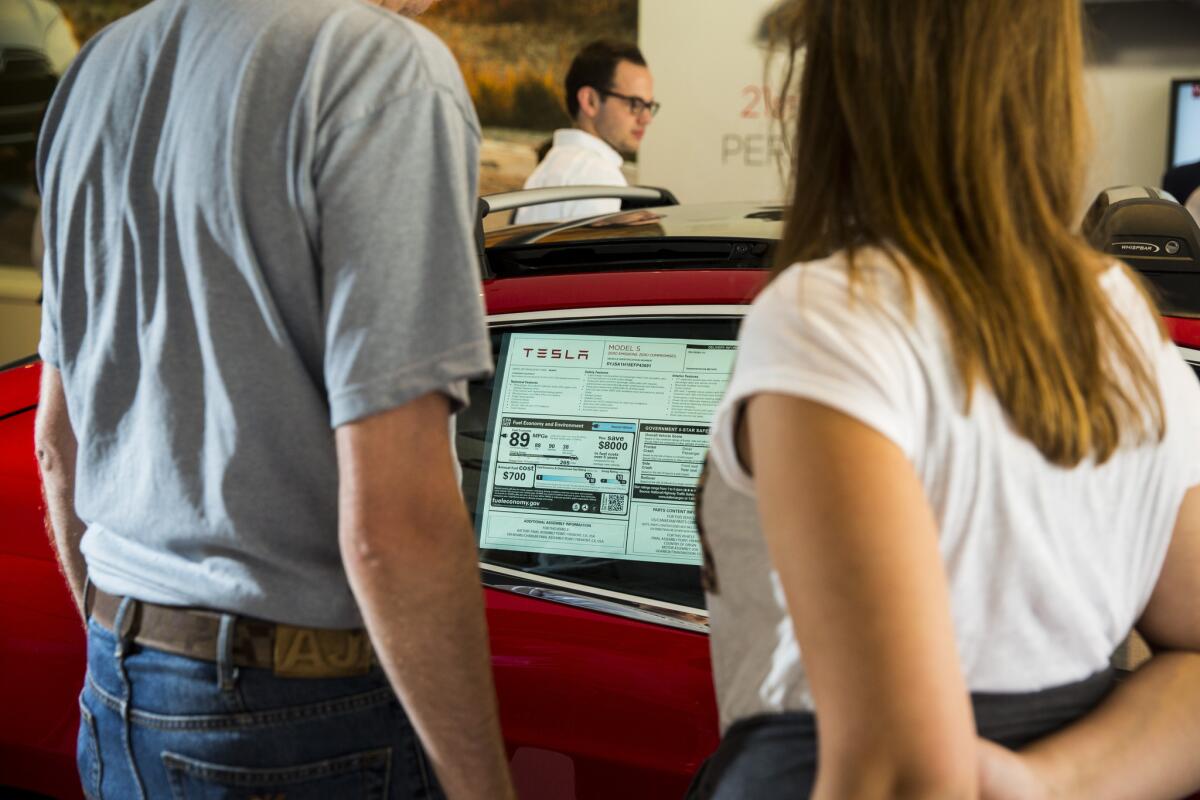More than $1 billion in cap-and-trade funds unspent as budget negotiations begin anew

People check out a Tesla Model S inside the electric carmaker’s Santa Monica showroom. California’s electric vehicle rebate program could be in danger of running out if lawmakers and the governor don’t sign off on a plan to spend cap-and-trade funds soon.
When budget negotiations were in danger of stalling last year, Gov. Jerry Brown and state lawmakers put off deciding how to spend more than $1 billion in funds collected from the auction of greenhouse gas pollution credits.
At the time, Brown said he expected the differences between his proposal and the Legislature’s to be resolved “fairly expeditiously in the next few days or weeks.”
Seven months later, a deal remains elusive.
Now, with next year’s budget proposal on the table, advocates and environmentalists remain anxious about what will become of the cache of funds raised through the state’s cap-and-trade program — created as part of the landmark 2006 law to combat climate change.
The money has been left unspent in the state’s Greenhouse Gas Reduction Fund.
By law, it must be used on programs to cut emissions — 60% is earmarked to pay for construction of a high-speed rail, affordable housing and other transportation programs. That portion already is being spent.
But the remainder — which totals about $1.6 billion — is waiting for consensus between legislators and the governor on how it should be spent. (The cap-and-trade coffers have been bolstered because the program now applies to transportation fuels, which account for an estimated 40% of California’s carbon emissions.)
In the meantime, environmentalists say, key programs could be at risk. The state’s electric vehicle rebate program, for example, could run out of funds in April unless Brown and the Legislature sign off on new spending.
“We can’t hit pause on climate change, and we shouldn’t be hitting pause on critical investments and climate change solutions,” said Alex Jackson, an attorney for the Natural Resources Defense Council.
------------
FOR THE RECORD
10:45 a.m.: An earlier version of this article referred to the Natural Resources Defense Fund. The organization is the Natural Resources Defense Council.
------------
“California has positioned itself as a real leader,” he said. “For us to be squabbling over the precise allocation of needed climate investments really sends the wrong message at a crucial time.”
The NRDC is one of dozens of organizations that has signed an open letter urging that a deal on spending the cap-and-trade funds be reached well in advance of this year’s budget talks.
“We can’t hit pause on climate change. ... For us to be squabbling over the precise allocation of needed climate investments really sends the wrong message at a crucial time.”
— Alex Jackson, attorney for the Natural Resources Defense Fund
Before the negotiations broke down last year, the Senate sought to place greater focus on helping the communities most affected by pollution. The Assembly had asked for a slew of new programs, including funding for transit passes. Brown’s plan sought to keep a $500-million reserve in the account.
“There is still unfinished work to be done so that no program that can reduce GHG emissions … is left behind,” the letter from environmentalists said.
But rather than allocate the leftover money, the Brown administration is focused on developing a long-term plan.
In next year’s budget, the governor has proposed spending all the discretionary money in the cap-and-trade fund — which is expected to grow to $3.1 billion by June 2017 — on a handful of programs to combat emissions like methane and smoke as well as on transit projects and electric vehicle rebates. He also wants to keep a $500-million reserve in the account.
H.D. Palmer, a spokesman for Brown’s Department of Finance, said that the governor thinks the spending should not be piecemeal, and that the administration sees no reason to spend some now and some later.
Assembly Speaker Toni Atkins (D-San Diego) agrees. In a statement, she said that cap-and-trade spending should become part of “the comprehensive budget process.”
In the opposite camp is Assemblyman Jimmy Gomez (D-Echo Park), who has introduced legislation calling on his colleagues to hammer out a deal to spend last year’s money in the coming months.
“Waiting a whole year to get almost $1 billion out the door, I think it’s a lack of leadership from myself as well as the Legislature as a whole,” Gomez said.
A spokesman for Senate Pro Tem Kevin de León (D-Los Angeles) said he would like to get current-year funding decided “as soon as possible.”
Some environmental advocates fear that the chances of resolving the issue are narrowing with every passing day. And when it comes to combating climate change, they say, timing matters.
See more of our top stories on Facebook >>
“There’s a huge, huge opportunity to invest these funds — sooner rather than later — in projects that reduce emissions and have multiple benefits for Californians,” said Michelle Passero, a senior climate policy adviser for the Nature Conservancy. “Global warming keeps marching ahead, and the sooner we make these investments, the sooner we can achieve reductions.”
For more on California politics, follow me @cmaiduc
ALSO
FBI releases video of Oregon occupier’s fatal shooting by state police
Woman arrested on suspicion of helping trio escape from Orange County jail
If Chargers move here, it seems likely they’d be Stan Kroenke’s tenant
More to Read
Get the L.A. Times Politics newsletter
Deeply reported insights into legislation, politics and policy from Sacramento, Washington and beyond. In your inbox three times per week.
You may occasionally receive promotional content from the Los Angeles Times.











